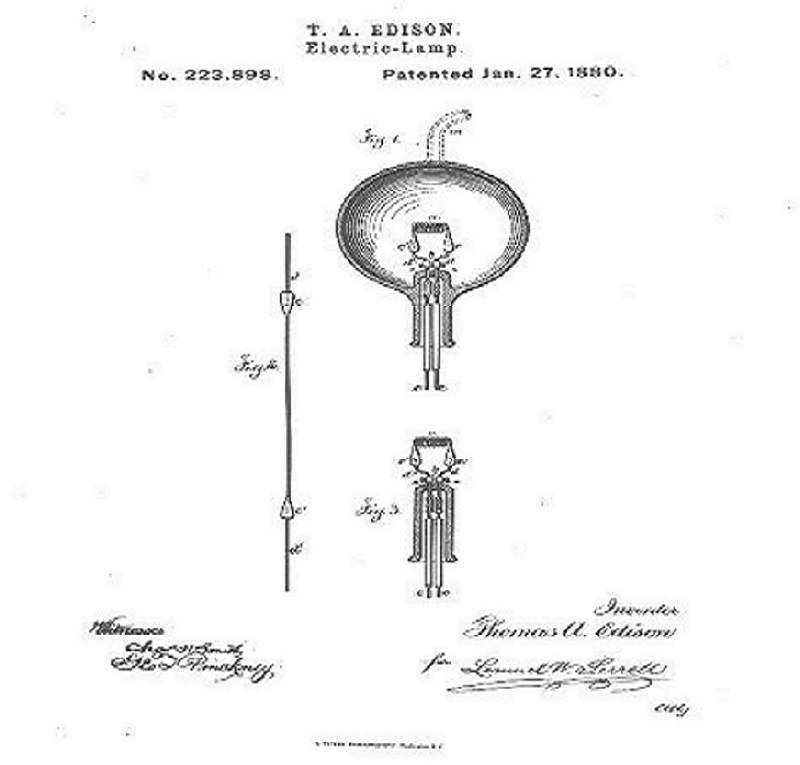If there is one invention that not only changed the way the people lived at the time it was made, but has gone on to be used by almost the entire world ever since, then that invention is the electric light bulb. The history of the light bulb’s development and patent ownership is an interesting one, involving the man who has been described as America’s greatest inventor, as well as one of its most controversial: Thomas Edison.
Edison was, of course, not the first person to invent a kind of electric light bulb. His breakthrough US patent application, which described what became the most commercially viable arrangement, was filed in 1879 and the patent was granted in 1880. However, as far back as 1800, Alessandra Volta had developed a method for conducting electricity using, amongst other materials, copper wire.
In 1840, British scientist Warren de la Rue developed a light bulb with a platinum filament and, although this bulb was highly efficient, the high cost of platinum prevented this bulb from succeeding commercially. Many others, including Henry Woodward, Mathew Evans, Humphry Davy, James Bowman Lindsay, Moses Farmer, William Sawyer, Joseph Swan, and Heinrich Göbel, designed incandescent lamps taking various forms, none of which proved to be particularly successful from a commercial point of view.
Edison employed a team of scientists at his Menlo Park, New Jersey laboratory, to overcome the problem associated with these prior designs – which was down to the filament being used to conduct electricity. Edison realised that what was needed was a filament with a high electrical resistance, which could use a small amount of current to achieve long- lasting light. Edison’s team experimented with various filament materials, realising that carbon-based filament performed best and refining this to develop a carbonised bamboo filament which could burn for over 1200 hours before failing.
Edison knew how to use the patent system to his advantage – in the case of the light bulb, not only did he purchase many of his competitor’s patents, but he filed his breakthrough “Electric Lamp” patent application covering various ways to build a light bulb, listing a variety of carbonised materials which could be used as the filament, including the bamboo which was eventually settled on. Once Edison had hit on the combination that was the most commercially viable, he wasn’t shy to pursue infringers and protect “his” invention.
Once Edison has secured his Electric Lamp patent, litigation inevitably followed. The most prominent case involved George Westinghouse and was, no doubt, linked to Edison and Westinghouse’s wider battle over the provision of electrical power to the masses.
While Westinghouse convincingly argued that Edison was not first to invent the light bulb, the court found that he was first to successfully draft a patent which covered the specific method of utilising a carbon filament, and the patent was drafted in such a way that not only did it cover the later development of a carbonised bamboo filament, but it also meant that there was almost no route around the patent to allow someone to develop a commercially successful light bulb that did not infringe Edison’s patent.

Edison worked with a team of 14 or so engineers, machinists, and physicists—collectively known as ‘muckers’.
Another example of Edison’s patent-savvy outlook is that, whilst other researchers at Edison’s laboratory undoubtedly contributed to the development of the light bulb, it was never able to be shown that anyone else had made a specific contribution.
Whilst Edison’s patent know-how undoubtedly furthered his position, he had also built a strong business by this time. This fact, coupled with his advanced PR strategies, meant that anyone looking to enter into Edison’s field of business (even someone with the financial backing of Westinghouse) could not realistically hope to do so without having to battle against Edison – a battle that most competitors were not able to win.
About Dawn Ellmore Employment
Dawn Ellmore Employment was incorporated in 1995 and is a market leader in intellectual property and legal recruitment.


